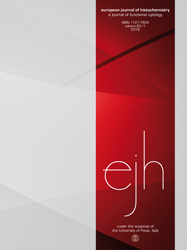 Smart Citations
Smart CitationsSee how this article has been cited at scite.ai
scite shows how a scientific paper has been cited by providing the context of the citation, a classification describing whether it supports, mentions, or contrasts the cited claim, and a label indicating in which section the citation was made.
Histological and histochemical analysis of the gastrointestinal tract of the common pipistrelle bat (Pipistrellus pipistrellus)
Bats have a very high mass-specific energy demand due to small size and active flight. European bat species are mostly insectivorous and the morphology of the gastrointestinal tract should be adapted accordingly. This study investigated the general anatomy by histology and the function by analysing carbohydrate distribution in particular of the mucus of the GI tract of the insectivorous bat Pipistrellus pipistrellus. The GI tracts of three individuals were dissected, fixed in formaldehyde, and embedded in paraffin wax. The tissues and cells of the GI tract of P. pipistrellus were analysed by classical (Acid Alizarin Blue, Haematoxylin-Eosin, and Masson Goldner Trichrome), histochemical (periodic acid-Schiff, Alcian blue at pH 2.5) and lectin histochemical (lectins WGA and HPA) staining procedures. The GI tract of P. pipistrellus was organised into the typical mammalian layers. The short, narrow, and thin-walled esophagus was simple with a folded stratified squamous epithelium without glands but mucous surface cells secreting neutral mucus. The stomach was globular shaped without specialisation. Mucous surface cells produced neutral mucus whereas neck and parietal cells secreted a mixture of neutral and acid mucus. Chief cell surface was positive for N-acetylglucosamine and the cytoplasm for N-acetylgalactosamine residues. The intestine lacked a caecum and appendix. The small intestine was divided into duodenum, jejunum‑ileum and ileum‑colon. The epithelium consisted of columnar enterocytes and goblet cells. The large intestine was short, only represented by the descending colon-rectum. It lacked villi and the mucosa had only crypts of Lieberkühn. Towards the colon-rectum, goblet cells produced mucus with N-acetylglucosamine residues increasing in acidity except in colon-rectum where acidity was highest in the base of crypts. Along the tube the surface of enterocytes was positive for N-acetylglucosamine and N-acetylgalactosamine. All over the mucus filling the lumen of the GI tract was positive for N-acetylglucosamine and increased in acidity in all parts except of the stomach. In conclusion, the simple GI tract showed an anatomical reduction of tissue enabling for a short retention time and a reduction of the load carried during flight: short GI tract, lack of lymphoid tissue, missing of glands in certain regions, and a distinct pattern of mucus distribution, indicating different physiological functions of these areas. The GI tract of P. pipistrellus was typical for an insectivorous species probably representing the ancestral condition.
How to Cite
PAGEPress has chosen to apply the Creative Commons Attribution NonCommercial 4.0 International License (CC BY-NC 4.0) to all manuscripts to be published.








